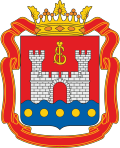
Back Oblast Kaliningrad ACE Kaliningrad-oblast Afrikaans ካሊኒንግራድ ኦብላስት Amharic Provincia de Kaliningrad AN مقاطعة كالينينغراد Arabic كالينينجرادسكايا ARZ Óblast de Kaliningráu AST Kalininqrad vilayəti Azerbaijani کالینینقراد اوبلاستی AZB Калининград өлкәһе Bashkir
Kaliningrad Oblast | |
|---|---|
| Калининградская область | |
|
| |
| Anthem: Anthem of Kaliningrad Oblast[3] | |
 Location in Russia (red) | |
 Location in Europe (dark green) | |
| Coordinates: 54°48′N 21°25′E / 54.800°N 21.417°E | |
| Country | Russia |
| Federal district | Northwestern[1] |
| Economic region | Kaliningrad[2] |
| Administrative center | Kaliningrad |
| Government | |
| • Body | Legislative Assembly[4] |
| • Governor[5] | Alexey Besprozvannykh |
| Area | |
• Total | 15,125 km2 (5,840 sq mi) |
| • Rank | 76th |
| Population | |
• Total | 1,029,966 |
• Estimate (January 2020)[8] | 1,012,253 |
| • Rank | 56th |
| • Density | 68/km2 (180/sq mi) |
| • Urban | 76.8% |
| • Rural | 23.2% |
| Time zone | UTC+2 (MSK–1 |
| ISO 3166 code | RU-KGD |
| License plates | 39, 91 |
| OKTMO ID | 27000000 |
| Official languages | Russian[10] |
| Website | http://www.gov39.ru |
Kaliningrad Oblast is the westernmost part of Russia. It is a small flat province separated from the rest of the country by the Baltic Sea and two European Union and NATO members: Poland to the south and Lithuania to the north and east.
Half of the oblast's one million people live in the city of Kaliningrad, formerly known as Königsberg, which is the provincial capital. Due to sanctions the economy is dependent on subsidies and the military.[12][13] The port city of Baltiysk is Russia's only port on the Baltic Sea that remains ice-free in winter.
Various peoples, including Lithuanians, Germans and Poles, lived on the land which is now Kaliningrad. In the 18th century it was East Prussia, which became part of Germany. But after defeat in World War II in the mid-20th century the Germans fled or were expelled, and the victorious Soviet Union repopulated the territory, mostly with Russians.
- ^ Президент Российской Федерации. Указ №849 от 13 мая 2000 г. «О полномочном представителе Президента Российской Федерации в федеральном округе». Вступил в силу 13 мая 2000 г. Опубликован: "Собрание законодательства РФ", No. 20, ст. 2112, 15 мая 2000 г. (President of the Russian Federation. Decree #849 of May 13, 2000 On the Plenipotentiary Representative of the President of the Russian Federation in a Federal District. Effective as of May 13, 2000.).
- ^ Госстандарт Российской Федерации. №ОК 024-95 27 декабря 1995 г. «Общероссийский классификатор экономических регионов. 2. Экономические районы», в ред. Изменения №5/2001 ОКЭР. (Gosstandart of the Russian Federation. #OK 024-95 December 27, 1995 Russian Classification of Economic Regions. 2. Economic Regions, as amended by the Amendment #5/2001 OKER. ).
- ^ Law #90
- ^ Charter of Kaliningrad Oblast, Article 17
- ^ Charter of Kaliningrad Oblast, Article 28
- ^ "Сведения о наличии и распределении земель в Российской Федерации на 01.01.2019 (в разрезе субъектов Российской Федерации)". Federal Service for State Registration, Cadastre and Cartography. Archived from the original on 9 February 2022. Retrieved 29 August 2023.
- ^ "2020 Census data". Archived from the original on 1 September 2022. Retrieved 16 December 2022.
- ^ "Archived copy". Archived from the original on 24 January 2020. Retrieved 6 November 2020.
{{cite web}}: CS1 maint: archived copy as title (link) - ^ "Об исчислении времени". Официальный интернет-портал правовой информации (in Russian). 3 June 2011. Retrieved 19 January 2019.
- ^ Official throughout the Russian Federation according to Article 68.1 of the Constitution of Russia.
- ^ Charter of Kaliningrad Oblast, Article 3
- ^ "Kaliningrad's Economy Buckles Under Sanctions". jamestown.org. Retrieved 10 February 2025.
- ^ Cookson, J (30 January 2025). "Trump's out-of-the-box approach is perfect to help demilitarize Kaliningrad". Atlantic Council. Retrieved 10 February 2025.
© MMXXIII Rich X Search. We shall prevail. All rights reserved. Rich X Search

